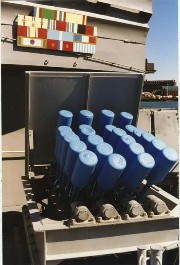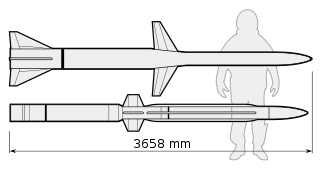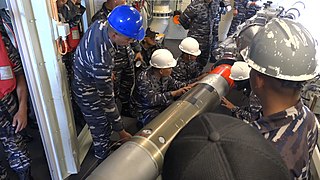Related Research Articles

A missile is an airborne ranged weapon capable of self-propelled flight aided usually by a propellant, jet engine or rocket motor.

The Mark 46 torpedo is the backbone of the United States Navy's lightweight anti-submarine warfare torpedo inventory and is the NATO standard. These aerial torpedoes are designed to attack high-performance submarines. In 1989, an improvement program for the Mod 5 to the Mod 5A and Mod 5A(S) increased its shallow-water performance. The Mark 46 was initially developed as Research Torpedo Concept I, one of several weapons recommended for implementation by Project Nobska, a 1956 summer study on submarine warfare.

An anti-submarine weapon (ASW) is any one of a number of devices that are intended to act against a submarine and its crew, to destroy (sink) the vessel or reduce its capability as a weapon of war. In its simplest sense, an anti-submarine weapon is usually a projectile, missile or bomb that is optimized to destroy submarines.

The Sting Ray is a British acoustic homing lightweight torpedo (LWT) manufactured by GEC-Marconi, who were later bought out by BAE Systems. It entered service in 1983.

The Bréguet Br.1050 Alizé is a French carrier-based anti-submarine warfare aircraft. It was developed in the 1950s, based loosely on the second prototype Bréguet Vultur attack aircraft which had been modified into the Bréguet Br.965 Épaulard anti-submarine warfare aircraft.

The AIM-152 Advanced Air-to-Air Missile (AAAM) was a long-range air-to-air missile developed by the United States. The AIM-152 was intended to serve as the successor to the AIM-54 Phoenix. The program went through a protracted development stage but was never adopted by the United States Navy, due to the ending of the Cold War and the reduction in threat of its perceived primary target, Soviet supersonic bombers. Development was cancelled in 1992.

Anti-submarine warfare is a branch of underwater warfare that uses surface warships, aircraft, submarines, or other platforms, to find, track, and deter, damage, or destroy enemy submarines. Such operations are typically carried out to protect friendly shipping and coastal facilities from submarine attacks and to overcome blockades.

The Zvezda Kh-35 is a Soviet turbojet subsonic cruise anti-ship missile. The missile can be launched from helicopters, surface ships and coastal defence batteries with the help of a rocket booster, in which case it is known as Uran or Bal. It is designed to attack vessels up to 5,000 tonnes.
The People's Liberation Army Navy (PLAN) is the naval branch of the People's Liberation Army (PLA), the armed forces of the People's Republic of China. The PLAN force consists of approximately 250,000 men and over a hundred major combat vessels, organized into three fleets: the North Sea Fleet, the East Sea Fleet, and the South Sea Fleet.

An anti-submarine missile is a standoff anti-submarine weapon, often a specialized variant of anti-ship missile. Anti-submarine systems usually include a jet or rocket engine and an explosive warhead aimed directly at a submarine. In these systems, a depth charge or a homing torpedo is carried from a launch ship, or other platform, to the vicinity of a target.
The CY-1 is a Chinese anti-submarine rocket carried on a variety of surface platforms, including the Luda class missile destroyers and Jiangwei class missile frigates. A series of CY ASW missiles have been developed based on CY-1. To date only a small number of CY-1 is known to have been produced and deployed on trial basis, despite the fact that it had first appeared on the defense exhibitions held in China in the late 1980s.

The A244-s is an Italian lightweight, fire-and-forget torpedo employed for anti-submarine warfare. It can be launched from surface vessels or aircraft and locates the target using an acoustic seeker.

The Nimrod is a long-range air-to-surface missile developed by Israel Aerospace Industries. While designed for mainly anti-tank warfare, it provides standoff strike ability against a variety of point targets such as armoured personnel carriers (APCs), ships, bunkers, personnel concentrations, and guerrillas.

Yu-2 torpedo was a Chinese development of the unguided straight-running Soviet ASuW RAT-52 torpedo with passive acoustic homing capability added. The historical background of Yu–2 is identical to that of Yu-1 torpedo and Yu-4 torpedo. Contrary to the higher number assigned, Yu-2 torpedo was the first Chinese domestically produced torpedo entering service, ahead of the Yu-1 torpedo.

Project Kingfisher was a weapons-development program initiated by the United States Navy during the latter part of World War II. Intended to provide aircraft and surface ships with the ability to deliver torpedoes to targets from outside the range of defensive armament, six different missile concepts were developed; four were selected for full development programs, but only one reached operational service.

The Torpedo Advanced Light (TAL) Shyena is the first indigenous advanced lightweight anti-submarine torpedo of India, developed by the Naval Science and Technological Laboratory (NSTL) of the Defence Research and Development Organisation (DRDO) for the Indian Navy. The lightweight torpedo can be launched by ships, helicopters and previously the now retired Ilyushin Il-38, named after the divine hawk identified with Agni.
The Mark 21 Mod 2 torpedo, was a passive acoustic homing variant of the Mark 13 torpedo. It used the widely used Mark 13 torpedo as a basis, with the addition of passive acoustic homing developed by Bell Labs.
A nuclear torpedo is a torpedo armed with a nuclear warhead. The idea behind the nuclear warheads in a torpedo was to create a much bigger explosive blast. Later analysis suggested that smaller, more accurate, and faster torpedoes were more efficient and effective.

The SUM-N-2 Grebe, also known as Kingfisher E and SUM-2, was a rocket- and pulsejet-powered anti-ship and anti-submarine missile developed by the United States Navy in the late 1940s. Intended to allow a ship to deliver a torpedo at a significant distance from the launch location, it proved impractical in trials, and did not enter operational service.
Numerous 53 cm torpedoes have been used by the Imperial Japanese Navy and its successor, the Japan Maritime Self-Defense Force, since their first development just before the First World War.